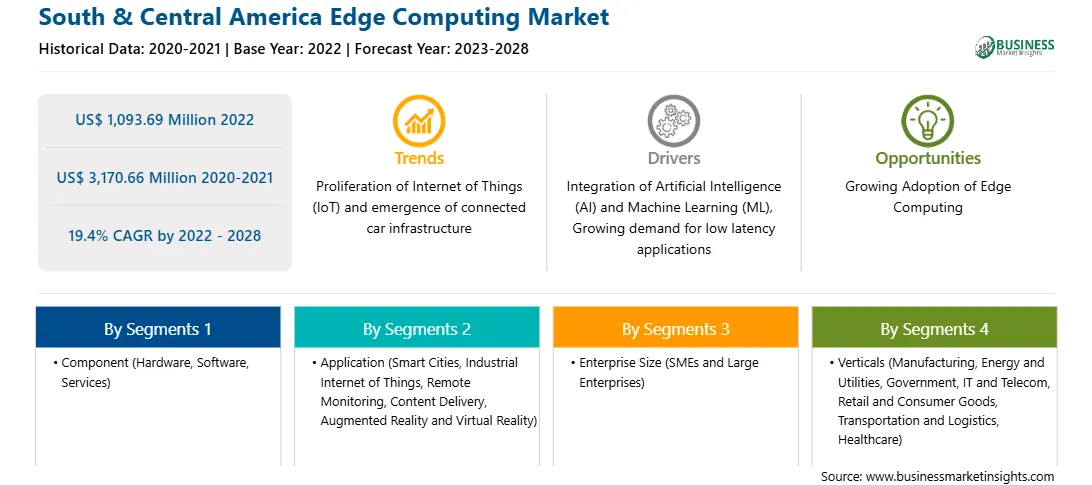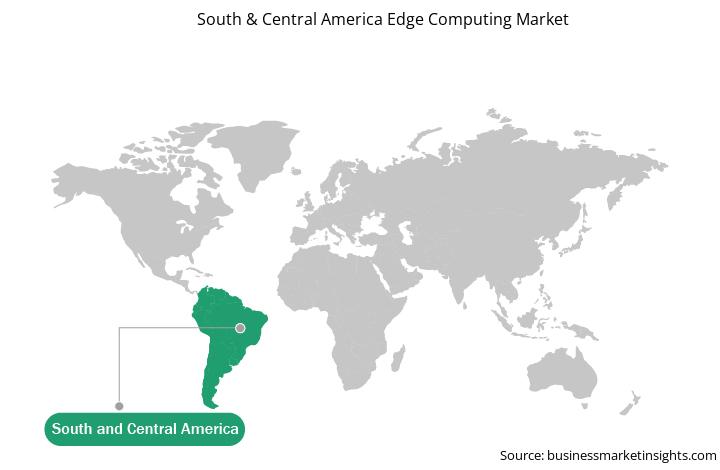South & Central America Edge Computing Market
No. of Pages: 142 | Report Code: BMIRE00028907 | Category: Technology, Media and Telecommunications
No. of Pages: 142 | Report Code: BMIRE00028907 | Category: Technology, Media and Telecommunications
The introduction of autonomous cars is on the verge of undergoing extensive research because the autonomous system ensures passenger safety and security. Autonomous vehicles can connect to the edge to improve safety, enhance efficiency, reduce accidents, and decrease traffic congestion. These autonomous cars are equipped with a variety of sensors, and the large amount of data created by these sensors needs to be processed quickly. Machine learning (ML) algorithms used in self-driving cars extract insights from raw data to determine road conditions and make decisions based on them. The growing integration of V2X (Vehicle-To-Everything) technology in the autonomous vehicles would offer potential opportunities for the market growth in the coming years. The automotive vehicles having an interactive advanced driver-assistance system (ADASs) and cooperative intelligent transport systems (C-ITS) are associated as connected cars. The connected-vehicle safety applications are designed to increase situation awareness and mitigate traffic accidents through vehicle-to-vehicle (V2V) and vehicle-to-infrastructure (V2I) communications. The V2X technology accelerates the huge computing demand on autonomous driving edge computing systems. The technology focuses mainly on vehicle-to-vehicle (V2V) and vehicle-to-infrastructure (V2I) goals. The significant increase in deployment of edge computing facilities in road infrastructure, many autonomous driving applications have started leveraging V2X communications to make the in-vehicle edge computing system efficient which is driving the market growth. A few benefits of edge computing in the autonomous vehicles include optimized data, faster 5G response times, infrastructure security, and localized data caching. Thus, edge computing is most widely adopted in these vehicles, which is expected to provide potential opportunity for the market growth during the forecast period.
In the last 15 years, economies in South America have progressed at a faster rate on average than the economies of many developed countries. However, they still lag in terms of technological advancements. Coupled with growing urbanization—the increasing deployment of advanced technologies in industries, rising need for remote monitoring, and popularity of real-time streaming solutions are the prominent factors propelling the demand for IoT solutions in SAM. According to the IoT Snapshot 2022 study, 47% of companies in SAM countries have already started implementing IoT, and pilot projects or initiatives in production have grown by 15% from 2020. These factors underline the need for edge data centers and cloud at the edge. Moreover, the adoption of Big Data and IoT will continue to attract investments in modular data centers from colocation, cloud, Internet, and telecommunication providers. For instance, in February 2022, AWS announced a list of 26 countries, including Colombia, Argentina, Peru, Mexico, Brazil, and Chile, in which it was planning to launch Local Zones for its Edge locations. As per the data published by Ericsson, GSMA Intelligence, the growth in smartphone penetration and mobile Internet usage would trigger data traffic by more than sixfold by 2024 in Argentina, which is expected to drive the demand for edge computing in the coming years. As per a 2022 report by Statista, 60.6% of the web traffic in Brazil is generated via mobile devices, while the web traffic via desktops has lowered to 38.65%. Such a rise in network traffic is fueling the demand for edge computing in SAM.
Strategic insights for the South & Central America Edge Computing provides data-driven analysis of the industry landscape, including current trends, key players, and regional nuances. These insights offer actionable recommendations, enabling readers to differentiate themselves from competitors by identifying untapped segments or developing unique value propositions. Leveraging data analytics, these insights help industry players anticipate the market shifts, whether investors, manufacturers, or other stakeholders. A future-oriented perspective is essential, helping stakeholders anticipate market shifts and position themselves for long-term success in this dynamic region. Ultimately, effective strategic insights empower readers to make informed decisions that drive profitability and achieve their business objectives within the market. The geographic scope of the South & Central America Edge Computing refers to the specific areas in which a business operates and competes. Understanding local distinctions, such as diverse consumer preferences (e.g., demand for specific plug types or battery backup durations), varying economic conditions, and regulatory environments, is crucial for tailoring strategies to specific markets. Businesses can expand their reach by identifying underserved areas or adapting their offerings to meet local demands. A clear market focus allows for more effective resource allocation, targeted marketing campaigns, and better positioning against local competitors, ultimately driving growth in those targeted areas.South & Central America Edge Computing Strategic Insights

South & Central America Edge Computing Report Scope
Report Attribute
Details
Market size in 2022
US$ 1,093.69 Million
Market Size by 2028
US$ 3,170.66 Million
Global CAGR (2022 - 2028)
19.4%
Historical Data
2020-2021
Forecast period
2023-2028
Segments Covered
By Component
By Application
By Enterprise Size
By Verticals
Regions and Countries Covered
South and Central America
Market leaders and key company profiles
South & Central America Edge Computing Regional Insights

The South & Central America edge computing market is segmented into component, applications, enterprise size, verticals, and country.
Based on component, the South & Central America edge computing market is segmented into hardware, software, and services. The hardware segment registered the largest South & Central America edge computing market share in 2022.
Based on organization Size, the South & Central America edge computing market is segmented into SMEs and large enterprises. The large enterprises segment held a larger South & Central America edge computing market share in 2022.
Based on application, the South & Central America edge computing market is segmented into smart cities, industrial internet of things (IIOT), remote monitoring, content delivery, augmented reality and virtual reality, and others. The smart cities segment held the largest South & Central America edge computing market share in 2022.
Based on Verticals, the South & Central America edge computing market is segmented into manufacturing, energy and utilities, government, IT and telecom, retail and consumer goods, transportation and logistics, healthcare, and others. The IT and telecom segment held the largest South & Central America edge computing market share in 2022.
Based on country, the South & Central America edge computing market has been categorized into Brazil, Argentina, and the Rest of South & Central America. Brazil dominated the South & Central America edge computing market in 2022.
ADLINK Technology Inc; Amazon Web Services; Dell Technologies; EdgeConnex Inc; Hewlett Packard Enterprise Development LP (HPE); IBM Corporation; and Microsoft Corporation are some of the leading companies operating in the South & Central America edge computing market.
The South & Central America Edge Computing Market is valued at US$ 1,093.69 Million in 2022, it is projected to reach US$ 3,170.66 Million by 2028.
As per our report South & Central America Edge Computing Market, the market size is valued at US$ 1,093.69 Million in 2022, projecting it to reach US$ 3,170.66 Million by 2028. This translates to a CAGR of approximately 19.4% during the forecast period.
The South & Central America Edge Computing Market report typically cover these key segments-
The historic period, base year, and forecast period can vary slightly depending on the specific market research report. However, for the South & Central America Edge Computing Market report:
The South & Central America Edge Computing Market is populated by several key players, each contributing to its growth and innovation. Some of the major players include:
The South & Central America Edge Computing Market report is valuable for diverse stakeholders, including:
Essentially, anyone involved in or considering involvement in the South & Central America Edge Computing Market value chain can benefit from the information contained in a comprehensive market report.